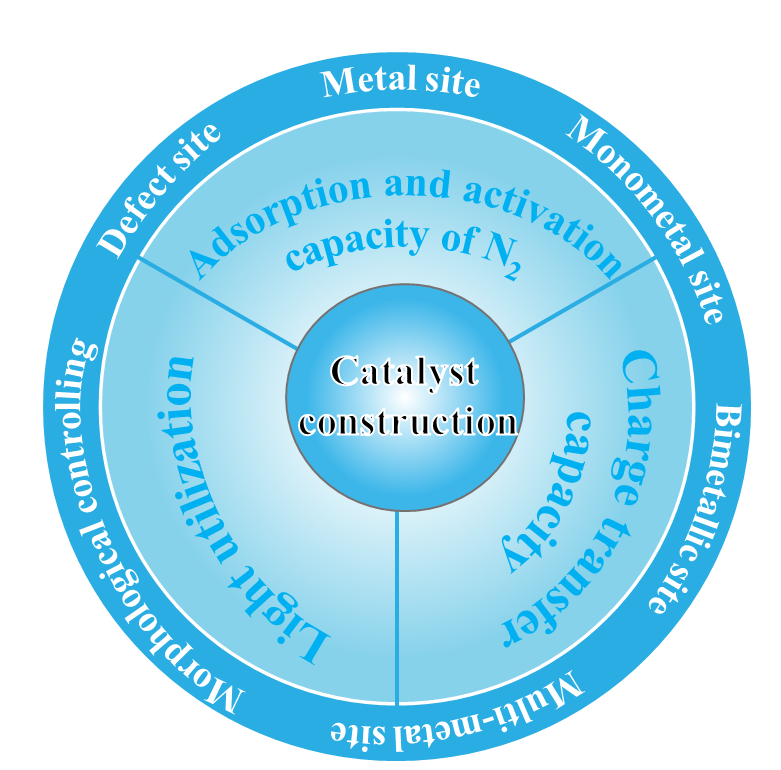 PDF(9459 KB)
PDF(9459 KB)


Performance Improvement Strategy of Photocatalytic Ammonia Synthesis Catalyst
Lijun Guo, Hong Yang, Shengjuan Shao, Yinqi Liu, Jianxin Liu
Prog Chem ›› 2024, Vol. 36 ›› Issue (6) : 939-948.
 PDF(9459 KB)
PDF(9459 KB)
 PDF(9459 KB)
PDF(9459 KB)
Performance Improvement Strategy of Photocatalytic Ammonia Synthesis Catalyst
Photocatalytic nitrogen fixation is driven by solar energy.N2and H2O are used to directly produce NH3at normal temperature and pressure,and the process has zero carbon emissions.It is one of the most promising artificial nitrogen fixation methods and has attracted wide attention from researchers in recent years.Limited by the difficult activation of N2,low utilization rate of photogenerated carrier and low utilization rate of sunlight,the ammonia production efficiency is still not high,so improving the ammonia production efficiency is the focus of research in the field of photocatalytic ammonia synthesis.Starting from the three important processes of N2adsorption activation,carrier separation and migration,and surface reaction,it is very promising to promote the activation and conversion of N2under mild conditions and produce NH3efficiently by reasonable modification of the catalyst.This paper mainly studied the modification of photocatalysts,summarized the influence of N2molecular adsorption and activation ability,photogenerated electron transfer ability and light utilization on the ammonia production efficiency,analyzed the research in recent years in these fields,and finally summarized the modification strategy of photocatalytic ammonia synthesis catalyst.
1 Introduction
2 Improving the adsorption and activation capacity of N2
2.1 Introducing defect site
2.2 Introducing metal site
3 Increased charge transfer capacity
3.1 Constructing the monometal mixed valence catalyst
3.2 Designing bimetallic site catalyst
3.3 Constructing multi-metal site catalyst
4 Improving light utilization
5 Conclusion and outlook

photocatalytic synthesis of ammonia / photocatalyst / active site / photogenic electron transfer ability / morphology control
| [1] |
|
| [2] |
|
| [3] |
|
| [4] |
|
| [5] |
|
| [6] |
|
| [7] |
|
| [8] |
|
| [9] |
|
| [10] |
|
| [11] |
|
| [12] |
|
| [13] |
|
| [14] |
|
| [15] |
|
| [16] |
|
| [17] |
|
| [18] |
|
| [19] |
|
| [20] |
|
| [21] |
|
| [22] |
|
| [23] |
|
| [24] |
|
| [25] |
|
| [26] |
|
| [27] |
|
| [28] |
|
| [29] |
|
| [30] |
|
| [31] |
|
| [32] |
|
| [33] |
|
| [34] |
|
| [35] |
|
| [36] |
|
| [37] |
|
| [38] |
|
| [39] |
|
| [40] |
|
| [41] |
|
| [42] |
|
| [43] |
|
| [44] |
|
| [45] |
|
| [46] |
|
| [47] |
|
| [48] |
|
| [49] |
|
| [50] |
|
| [51] |
|
| [52] |
|
| [53] |
|
| [54] |
|
| [55] |
|
| [56] |
Del Castillo T J,
|
| [57] |
|
| [58] |
|
| [59] |
|
| [60] |
|
| [61] |
|
| [62] |
|
| [63] |
|
| [64] |
|
| [65] |
Logadóttir,
|
| [66] |
|
| [67] |
|
| [68] |
|
| [69] |
|
| [70] |
|
| [71] |
|
| [72] |
|
| [73] |
|
| [74] |
|
| [75] |
|
| [76] |
|
| [77] |
|
| [78] |
|
| [79] |
|
| [80] |
|
| [81] |
|
| [82] |
|
| [83] |
|
| [84] |
|
| [85] |
(吴勇军. 浙江工业大学硕士论文, 2009.)
|
| [86] |
|
| [87] |
|
| [88] |
|
| [89] |
|
| [90] |
|
| [91] |
|
| [92] |
|
| [93] |
|
| [94] |
|
| [95] |
|
| [96] |
|
| [97] |
|
| [98] |
|
| [99] |
|
| [100] |
|
| [101] |
da Trindade L G,
|
| [102] |
|
| [103] |
|
| [104] |
|
| [105] |
|
| [106] |
|
| [107] |
|
/
| 〈 |
|
〉 |